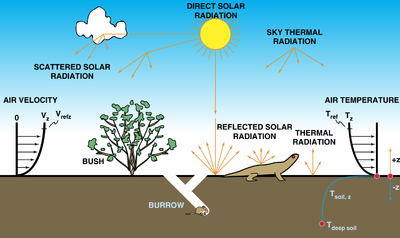Microclimate: Difference between revisions
No edit summary |
|||
| Line 1: | Line 1: | ||
Microclimate is the set of atmospheric conditions that occur in a local area as a result of environmental heterogeneity near the Earth’s surface (Geiger 1965). Microclimates play an integral role in ecosystem processes. Microclimatic variations in energy and moisture directly affect a number of key ecological processes in forest ecosystems occurring at multiple spatial and temporal scales. | Microclimate is the set of atmospheric conditions that occur in a local area as a result of environmental heterogeneity near the Earth’s surface (Geiger 1965). Microclimates play an integral role in ecosystem processes. Microclimatic variations in energy and moisture directly affect a number of key ecological processes in forest ecosystems occurring at multiple spatial and temporal scales. [[File:Microclimate1.png|400px|thumb|right|Schematic of microclimatic processes relating to heat and water transfer of an organism, Kearney et al]] | ||
==Influences on Microclimate== | ==Influences on Microclimate== | ||
The two major sources of microclimate variability are differences in energy and moisture, or temperature and humidity. However, succession is often community driven even if there are harsher abiotic limits set, so herbaceous and woody species also have an influence. Differences in temperature and humidity can have numerous drivers, including aspect, (direction that a slope faces,) successional stage, vegetation and canopy presence. The presence of bodies of water can also influence microclimate, as they may increase humidity and stabilize temperature. | The two major sources of microclimate variability are differences in energy and moisture, or temperature and humidity. However, succession is often community driven even if there are harsher abiotic limits set, so herbaceous and woody species also have an influence. Differences in temperature and humidity can have numerous drivers, including aspect, (direction that a slope faces,) successional stage, vegetation and canopy presence. The presence of bodies of water can also influence microclimate, as they may increase humidity and stabilize temperature. | ||
Revision as of 13:58, 5 May 2021
Microclimate is the set of atmospheric conditions that occur in a local area as a result of environmental heterogeneity near the Earth’s surface (Geiger 1965). Microclimates play an integral role in ecosystem processes. Microclimatic variations in energy and moisture directly affect a number of key ecological processes in forest ecosystems occurring at multiple spatial and temporal scales.

Influences on Microclimate
The two major sources of microclimate variability are differences in energy and moisture, or temperature and humidity. However, succession is often community driven even if there are harsher abiotic limits set, so herbaceous and woody species also have an influence. Differences in temperature and humidity can have numerous drivers, including aspect, (direction that a slope faces,) successional stage, vegetation and canopy presence. The presence of bodies of water can also influence microclimate, as they may increase humidity and stabilize temperature.
In Soils
Consideration of the microclimate is particularly important in soil ecology, as the heterogenous nature of soil means that numerous microclimates are present in very small areas of soils. This high heterogeneity of conditions may contribute to high soil biodiversity. Soil microclimate can affect macroaggregate dynamics and Aggregate formation. Soil erodability is reduced in warmer climates, which prevents the occurrence of fragile microaggregates caused by freeze-thaw events.